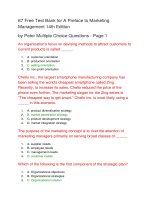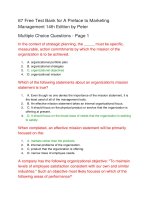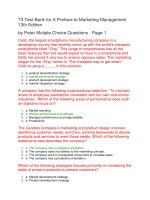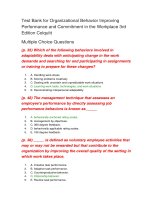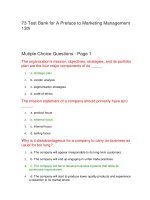Test bank for android how to program with an introduction to java 3rd edition by deitel
Bạn đang xem bản rút gọn của tài liệu. Xem và tải ngay bản đầy đủ của tài liệu tại đây (303.58 KB, 12 trang )
2.8 Internationalizing Your App
1
Test Bank for Android How to Program with an Introduction to Java 3rd
edition by Paul Deitel, Harvey Deitel
Link full download test bank: />Link full download solution manual: />Chapter 2—Welcome App
Introduction
Q1. Which of the following statements is false?
a. Android Studio’s layout editor enables you to build GUIs using drag-and-drop techniques.
b. You can edit the GUI’s XML directly.
c. In portrait orientation the device’s width is greater than its height.
d. Android’s Explore by Touch enables users to touch items on the screen and hear TalkBack
speak the corresponding descriptive text.
Answer: c. Actually, in portrait orientation the device’s height is greater than its width.
Q2. You can
an app so that you can provide localized strings in different languages.
a. translate.
b. convert.
c. transcribe.
d. internationalize.
Answer: d. internationalize.
Technologies Overview
No questions.
Android Studio
No questions.
LinearLayout, TextView and ImageView
Q1.
a. Layouts.
are views that contain and arrange other views.
b. TextViews.
c. ImageViews.
d. None of the above.
Answer: a. Layouts
Q2. Which of the following statements is false?
a. You can use a vertical LinearLayout to arrange an app’s text and image with each occupying
half the LinearLayout’s vertical space.
b. A LinearLayout also can arrange views horizontally.
c. The default GUI created by Android Studio already contains an ImageView.
2
Chapter 2 Chapter 2—Welcome App
d. You can use the layout editor’s Palette of views to drag and drop an
ImageView
onto a GUI, then configure its properties.
Answer: c. The default GUI created by Android Studio already contains an Im- ageView.
Actually, the default GUI created by Android Studio already contains a TextView.
Q3. Which of the following statements is true?
a. Extensible Markup Language (XML) is a natural way to express GUIs.
b. XML is human- and computer-readable text and, in the context of Android, helps you specify
the layouts and components to use, as well as their attributes, such as size, position, color, text size,
margins and padding.
c.You use XML files to store app resources, such as strings, numbers and colors.
d. All of the above are true.
Answer: d. All of the above are true.
App Resources
Q1. (True/False) It’s considered good practice to define all strings, numeric values and other values
in XML resource- files that are placed in the subfolders of a pro- ject’s resources folder.
Answer: False. Actually, it’s the res folder.
Q2. (True/False) For a TextView font color, you should typically create a color re- source using a
color selected from Google’s Material Design color palette.
Answer: True.
Accessibility
Q1. Which of the first three statements below is false?
a. Android provides accessibility features to help people with certain disabilities use their devices.
b. People with visual impairments can use Android’s TalkBack to allow a device to speak screen
text or text that you provide to help them understand the purpose and contents of a view.
c. Android’s Explore by Touch enables the user to touch the screen to hear TalkBack speak what’s
on the screen near the touch.
d. All of the above are true.
Answer. d. All of the above are true.
Internationalization
Q1. Which of the following statements is true?
a. To reach the most users with your apps, you should consider customizing them for various
locales and spoken languages.
b. Configuring your app so that it can be customized for various locales is known as localization.
c. Customizing your app for a specific locale is known as internationalization.
2.8 Internationalizing Your App
3
d. All of the above statements are false.
Answer. a. To reach the most users with your apps, you should consider cus- tomizing them for
various locales and spoken languages.
Creating an App
No questions.
Launching Android Studio
No questions.
Creating a New Project
Q1. A
is a group of related files, such as code files, resource files and im- ages that
make up an app.
a. folder
b. directory
c. solution
d. project
Answer: d. project.
Create New Project Dialog
Q1. Which of the following statements is false?
a. The package name normally begins with your company’s or institution’s Company Domain in
reverse. This is followed by a dot (.) and the app’s name in all lowercase letters with any spaces
removed.
b. By convention, package names use only lowercase letters.
c. The IDE sets the package name using the text you enter for Company Name and
Company Domain.
d. By default, Android Studio places new project folders in the subfolder AndroidStudioProjects in your user account directory.
Answer: c. The IDE sets the package name using the text you enter for Compa- ny Name and
Company Domain. Actually, the IDE sets the package name using the text you enter for
Application Name and Company Domain.
Target Android Devices Step
Q1. Which of the following statements is false?
a. The Minimum SDK is the minimum Android API level that’s required to run your app. This
allows your app to execute on devices supporting that API level and higher.
b. Lower Minimum SDK values enable your app to run on more devices.
c. Generally you should target the highest API level on which your app can run.
d. You must disable newer features that are not available on older platforms when your app is
installed on those platforms.
Answer: c. Generally you should target the highest API level on which your app can run.
Actually, generally you should target the lowest API level on which
4
Chapter 2 Chapter 2—Welcome App
your app can run, so your app can run on the largest possible number of devic- es.
Add an Activity to Mobile Step
Q1. Which type of app template is described by: "Used for a single-screen app (sim- ilar to Blank
Activity) that occupies the entire screen, but can toggle visibility of the device’s status bar and the
app’s app bar."
a. Empty Activity.
b. Fullscreen Activity.
c. Master/Detail Flow.
d. None of the above.
Answer: b. Fullscreen Activity.
Customize the Activity Step
No questions.
Android Studio Window
No questions.
Project Window
Q1. The
window provides access to all of the project’s files.
a. Organizer
b. Explorer
c. Project
d. None of the above.
Answer: c. Project
Q2. (True/False) You can have only one project open in the IDE at once.
Answer: False. Actually, you can have many projects open in the IDE at once—each in its own
window.
Q3. The
folder contains the files you’ll edit to create your apps’ GUIs and logic.
a. java
b. res
c. app
d. manifests
Answer: c. app
Editor Windows
Q1. The code editors for Java and XML help you write code quickly and correctly via
type, you can press Enter (or Return) to automatically finish a
—as you
2.8 Internationalizing Your App
5
Java code element or an XML element name, attribute name or value that is currently highlighted in
the code-completion window.
a. code-for-me
b. code-completion
c. automated coding
d. None of the above.
Answer: b. code-completion
Component Tree Window
Q1. When the layout editor is open in Design view, the
appears at the right
side of the IDE. This window shows the layouts and views (GUI components) that comprise the
GUI and their parent-child relationships—for example, a layout (the parent) might contain many
nested views (the children), including other layouts.
a. Project window
b. Properties window
c. Palette
d. Component Tree
Answer: d. Component Tree
App Resource Files
Q1. Layout files like activity_main.xml are app
folders of the project’s res folder.
a. code
b. descriptions
c. resources
d. None of the above.
Answer: Actually, it’s the res folder.
and are stored in sub-
Layout Editor
No questions.
Default GUI
Q1. With a
you can, for example, specify that one view should appear be- low
another and be centered horizontally within this layout.
a. LinearLayout
b. CenteredLayout
c. RelativeLayout
d. None of the above.
Answer: c. RelativeLayout
XML for the Default GUI
Q1. In a layout XML file, attribute values that begin with @, such as
6
Chapter 2 Chapter 2—Welcome App
@dimen/activity_vertical_margin are
with values defined in other
files.
a. resources
b. variables
c. dimentions
d. None of the above.
Answer: a. resources
Building the App’s GUI with the Layout Editor
Q1. Android Studio allows you to build your GUI by dragging and dropping views—such as
Text-Views, Image-Views and Buttons—onto the
.
a. GUI designer
b. layout designer
c. GUI editor
d. layout editor
Answer: d. layout editor
Adding an Image to the Project
Q1. Which of the following statements is false?
a. Android devices have various screen sizes, resolutions and pixel densities (that is, dots per inch
or DPI), so you typically provide images in various resolutions that the operating system chooses
based on a device’s pixel density. These are placed in drawable folders (in a project’s res
folder) that store images with different pixel densities.
b. Android Studio displays only one drawable folder containing the app’s drawa- ble resources,
even if your project contains resources for multiple densities.
c. If Android cannot find an image in the drawable folder that most closely matches the device’s
pixel density, Android will display nothing for that image.
d. Low-resolution images do not scale well. For images to render nicely, a high-pixel-density
device needs higher-resolution images than a low-pixel-density device.
Answer: c. If Android cannot find an image in the drawable folder that most closely
matches the device’s pixel density, Android will display nothing for that image. Actually, if
Android cannot find an image in the drawable folder that most closely matches the device’s
pixel density, Android will scale the version from another drawable folder up or down as
necessary.
Adding an App Icon
Q1. When your app is installed on a device, its icon and name appear with all other installed apps
in the
.
a. finder
b. explorer
c. launcher
d. None of the above.
2.8 Internationalizing Your App
7
Answer: c. launcher
Q2. Which of the first three statements about uploading apps to Google Play is false?
a. You can upload multiple versions of the app for various device- sizes and screen resolutions.
b. All images in the mipmap folders are uploaded with every version of your app.
c. You can remove extra drawable folders for specific pixel densities from a given app version
to minimize the total installation size for a particular device.
d. All of the above are true.
Answer: d. All of the above are true.
Changing RelativeLayout to a LinearLayout
Q1. When you open a layout XML file, the layout’s design appears in the layout edi- tor and the
layout’s views and their hierarchical relationships appear in the
window.
a. Outline
b. Tree
c. Layout Editor
d. Component Tree
Answer: d. Component Tree
Changing the LinearLayout’s id and orientation
Q1. Which of the following statements is false?
a. When a GUI is displayed in the layout editor, you can use the Properties window below the
Component Tree to configure the selected view’s properties.
b. You also can edit a view’s most commonly used properties by double clicking the view in the
canvas. The layout editor then displays a small dialog in which you can set the view’s id property
and other properties that depend on the specific view:
c. For a LinearLayout, you can set the orientation to specify whether the layout’s children are
arranged in horizontal or vertical orientation.
d. For an ImageView, you can set the src (source) of the image to display.
Answer: c. For a LinearLayout, you can set the orientation to specify wheth- er the layout’s
children are arranged in landscape or portrait orientation. Actually, for a LinearLayout,
you can set the orientation to specify whether the layout’s children are arranged in
horizontal or vertical orientation.
Configuring the TextView’s id and text Properties
Q1. Which of the following statements is false?
a. It’s considered good practice to place strings, string arrays, images, colors, font sizes,
dimensions and other app resources in XML files within the subfolders of the project’s res folder,
so these resources can be managed separately from your app’s Java code.
b. If you externalize color values, it becomes more difficult to update all components that use the
same color.
8
Chapter 2 Chapter 2—Welcome App
c. If you wish to localize your app in several languages, storing the strings separately
from the app’s code allows you to change them easily.
d. In your project’s res folder, the subfolder values contains a strings.xml file that’s used to
store the app’s default language strings—English for our apps. Answer: b. If you externalize
color values, it becomes more difficult to update all components that use the same color.
Actually, if you externalize color values, all components that use the same color can be
updated to a new color simply by changing the color value in a central resource file.
Configuring the TextView’s textSize Property—Scaled Pixels
and Density-Independent Pixels
Q1. Which of the following statements is false?
a. You should use density-independent pixels for font sizes, and scale-independent pixels for
dimensions of views and other screen elements.
b. Defining your GUIs with density-independent pixels enables the Android platform to scale the
GUI, based on the pixel density of a given device’s screen.
c. One density-independent pixel is equivalent to one pixel on a 160-dpi screen.
d. On a 240-dpi screen, each density-independent pixel will be scaled by a factor of 240/160 (i.e.,
1.5). So, a component that’s 100 density-independent pixels wide will be scaled to 150 actual pixels
wide.
Answer: a. You should use density-independent pixels for font sizes, and scale-independent
pixels for dimensions of views and other screen elements. Actually, you should use densityindependent pixels for dimensions of views and other screen elements, and scale-independent
pixels for font sizes.
Setting the TextView’s textColor Property
Q1. Which of the following statements is false?
a. When you need custom colors in your apps, Google’s Material Design guidelines recommend
using colors from the Material Design color palette.
b. Colors are specified as RGB (red-green-blue) or ARGB (alpha-red-green-blue) values.
c. An RGB value consists of integer values in the range 1–100 that define the amounts of red,
green and blue in the color, respectively.
d. Custom colors are defined in hexadecimal format, so the RGB components are values in the
range 00 (the hexadecimal value for 0) to FF (the hexadecimal value for 255).
Answer: c. An RGB value consists of integer values in the range 1–100 that de- fine the
amounts of red, green and blue in the color, respectively. Actually, an RGB value consists of
integer values in the range 0–255 that define the amounts of red, green and blue in the color,
respectively.
Setting the TextView’s gravity Property
Q1. To center the text in the TextView if it wraps to multiple lines, you can set its
property to center.
2.8 Internationalizing Your App
9
a. alignment
b. weight
c. gravity
d. positioning
Answer: c. gravity
Setting the TextView’s layout:gravity Property
No questions.
Setting the TextView’s layout:weight Property
Q1. A LinearLayout can proportionally size its children based on their
which specify the view’s relative size with respect to the layout’s other views.
a. layout:widths
b. layout:heights
,
c. layout:gravity
d. layout:weights
Answer: d. layout:weights
Q2. Android
checks your project for common errors, and makes sugges- tions for
better security-, enhanced performance, improved accessibility, internation- alization- and more.
Some checks occur as you build your apps and write code.
a. Cleanser.
b. Lint.
c. Error Checker.
d. None of the above.
Answer: b. Lint
Adding an ImageView to Display the Image
Q1. Which of the following statements about adding an ImageView to the GUI by dragging it from the
Palette’s Widgets section onto the canvas is false?
a. When you drag a view onto the canvas, the layout editor displays orange guide lines, green
guide lines and a tooltip.
b. The orange guide lines show the bounds of each existing view in the layout.
c. The green guide lines indicate where the new view will be placed with respect to the existing
views—by default, new views are added at the top of a vertical Linear- Layout, unless you
position the mouse below the orange box that bounds the lay- out’s bottommost view.
d. The tooltip displays how the view will be configured if you drop it at the current position.
Answer: c. The green guide lines indicate where the new view will be placed with respect to
the existing views—by default, new views are added at the top of a vertical LinearLayout,
unless you position the mouse below the orange box that bounds the layout’s bottommost
view. Actually, by default, new views are added
10
Chapter 2 Chapter 2—Welcome App
at the bottom of a vertical LinearLayout, unless you position the mouse above the orange box
that bounds the layout’s topmost view.
Previewing the Design
No questions.
Running the Welcome App
No questions.
Making Your App Accessible
Q1. Which of the following statements is false?
a. For people with visual disabilities, Android’s TalkBack can speak screen text or text that you
provide (when designing your GUI or programmatically) to help the user understand the purpose of
a view.
b. Android also provides Explore by Touch, which enables the user to hear TalkBack speak what’s
on the screen where the user touches.
c. Most standard Android views support accessibility.
d. You enable TalkBack in the Settings app under Accessibility. From that page, you also can
enable other Android accessibility features such as a larger default text size and the ability to use
gestures that magnify areas of the screen.
Answer: c. Most standard Android views support accessibility. Actually, all standard Android
views support accessibility.
Q2. For an ImageView there is no text for TalkBack to speak unless you provide it. It’s considered
good practice in Android to ensure that every view can be used with TalkBack by providing text for
the
property of any view that does not dis- play
text.
a. talkBack
b. description
c. hint
d. contentDescription
Answer: d. contentDescription
Internationalizing Your App
Q1. Which of the following statements is false?
a. To reach the largest possible audience, you should consider designing your apps so that they can
be customized for various locales and spoken languages.
b. You might also choose to use different colors, graphics and sounds based on the
locale.
c. When the user launches the app, Android automatically finds and loads the re- sources that
match the device’s locale settings.
2.8 Internationalizing Your App
11
d. Designing an app so it can be customized is known as localization. Customizing an app’s
resources for each locale is known as internationalization.
Answer: d. Designing an app so it can be customized is known as localization. Customizing an
app’s resources for each locale is known as internationalization. Actually, designing an app so
it can be customized is known as internationaliza- tion. Customizing an app’s resources for
each locale is known as localization.
Localization
No questions.
Naming the Folders for Localized Resources
Q1. Android uses a special folder-naming scheme to automatically choose the correct localized
resources. You can name these folders with region infor- mation—values-en-rUS would
contain a strings.xml file for United States Eng- lish and
would contain a strings.xml
file for United Kingdom English.
a. values-en-rUK
b. values-en-rEN
c. values-en-rGB
d. values-en-rBR
Answer: c. values-en-rGB
Q2. If localized resources are not provided for a given locale, Android uses the app’s default
resources—that is, those in the res folder’s
subfolder.
a. defaults
b. english
c. values
d. strings
Answer: c. values
Adding String Translations to the App’s Project
Q1. Android Studio provides a
existing strings in your app.
a. Translator
b. Translations Editor
c. Converter
d. None of the above. Answer: b.
Translations Editor
Localizing Strings
No questions.
for quickly and easily adding translations for
12
Chapter 2 Chapter 2—Welcome App
Testing the App in Spanish on an AVD
Q1. If Android cannot find a localized version of a string resource, it uses the default version in the
file.
a. res/values/defaults.xml
b. res/values/english.xml
c. res/values/values.xml
d. res/values/strings.xml
Answer: d. res/values/strings.xml
Testing the App in Spanish on a Device
No questions.
TalkBack and Localization
Q1. When you first switch your device to French and enable TalkBack, Android will automatically
download the
engine.
a. English-to-French.
b. Translations.
c. French text-to-speech.
d. French Transalation.
Answer: c. French text-to-speech.
Localization Checklist
No questions.
Professional Translation
No questions.

